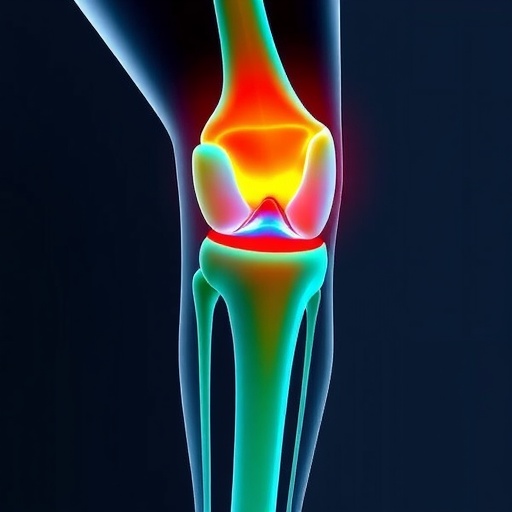
In a groundbreaking study published in the journal Annals of Biomedical Engineering, researchers have developed a geometric deep learning model capable of predicting knee joint biomechanics in real-time. This innovative approach focuses on the biomechanical effects associated with meniscal extrusion, a condition in which the meniscus, a crucial cartilage in the knee joint, moves out of its normal position. Meniscal extrusion can lead to various knee problems, including osteoarthritis, making it vital for clinicians to understand the mechanics involved to provide effective treatments.
The research led by Ma et al. employs a sophisticated framework that combines traditional biomechanics with advanced machine learning techniques. The model relies on geometric deep learning, a domain that integrates geometric and spatial data into neural network designs. Its architecture utilizes the underlying geometric properties of knee structures, enabling it to generate precise biomechanical predictions based on real-time data inputs. This dual emphasis on geometry and deep learning allows for more accurate assessments of knee joint dynamics than conventional methods.
One of the most significant contributions of this study is its potential application in clinical settings. Real-time prediction capabilities mean that orthopedic surgeons can monitor changes in knee joint biomechanics instantly, providing timely adjustments to treatment plans. Such responsiveness is particularly beneficial for patients undergoing rehabilitation or those with chronic knee conditions. By facilitating an adaptive and informed approach to patient care, this model stands to revolutionize treatment strategies in orthopedic practices.
The predictive model’s design is informed by the complexities of knee mechanics. It accounts for various factors, including joint angles, forces applied during movement, and the unique shapes of individual patients’ knee structures. Such pronounced detailing ensures that the output generated by the model is not only theoretical but also applicable to diverse populations with different anatomical traits. This level of customization enhances patient outcomes and sets the stage for personalized medicine in orthopedics.
Additionally, the study explores the implications of meniscal extrusion in greater detail. Traditionally, understanding the effects of this condition has required invasive procedures or extensive imaging techniques. However, the new model proposes a non-invasive alternative, cutting down on costs and time while enhancing the accuracy of biomechanical estimates. Such a technological leap underscores the importance of integrating artificial intelligence with traditional medical knowledge.
The results of the study highlight not only the efficacy of the deep learning model but also its ability to identify critical thresholds in knee biomechanics. For instance, the model can predict the point at which meniscal extrusion begins to significantly alter joint loading and stress distributions. Such insights are invaluable for preventative strategies aimed at mitigating the risks associated with knee injuries and degenerative diseases.
Moreover, the interdisciplinary nature of the research contributes to its validity and robustness. Collaboration between biomechanical engineers and computer scientists enriches the research framework, ensuring the model encompasses both the biological realities of knee dynamics and the computational strength of modern machine-learning algorithms. This convergence is emblematic of the future of medical research, where diverse expertise aligns to tackle complex biomedical challenges.
While the results are promising, the authors acknowledge the need for further validation through clinical trials. The transition from laboratory-based models to real-world applications often unveils unforeseen variables. Thus, ongoing evaluations will be crucial in refining the technology and confirming its clinical viability. However, the authors express optimism that the initial findings pave the way for a new era in biomechanical research and treatment.
As the study unfolds, it ignites discussions on the potential of deep learning technologies in other areas of medicine. The capacity to process large datasets can be harnessed elsewhere, from cardiovascular assessments to neurological conditions. Researchers envision a future where deep learning models provide real-time diagnostics across multiple medical fields, significantly enhancing patient care and outcomes.
This research is an important step towards integrating artificial intelligence into everyday clinical practice. By emphasizing predictive analytics, healthcare professionals can anticipate complications, tailor rehabilitation protocols, and monitor patient recovery more effectively. Furthermore, such technology could play a crucial role in training the next generation of orthopedic surgeons and healthcare professionals, who will need to navigate the integration of AI in clinical decision-making.
The application of this model also highlights the ethical considerations surrounding AI in healthcare. As algorithms dictate treatment paths, questions of bias and transparency emerge. It becomes imperative for researchers and clinicians alike to ensure that these technologies uphold high ethical standards and equity in patient care, regardless of demographic diversity. Amidst these challenges, the transition to AI-supported frameworks in medicine must be handled with care, enthusiasm, and a commitment to inclusivity.
As the field of biomedical engineering continues to evolve, the implications of this study resonate beyond the confines of the laboratory. It represents a shift towards a future where real-time data analytics enhance our understanding of complex biological systems, leading to better health outcomes for individuals. Researchers remain hopeful that this model could inspire similar innovations in biomechanics and beyond, ultimately forging new pathways in the pursuit of effective, patient-centered care.
This pioneering research signifies an extraordinary leap forward in our understanding of knee joint dynamics, set against the backdrop of modern computational advancements. With each iteration of machine learning tools, we edge closer to a future where personalized, real-time healthcare becomes the norm, changing the landscape of medicine as we know it.
Subject of Research: Geometric deep learning for real-time prediction of knee joint biomechanics under meniscal extrusion.
Article Title: A Geometric Deep Learning Model for Real-Time Prediction of Knee Joint Biomechanics Under Meniscal Extrusion.
Article References:
Ma, X., Xu, J., Fu, J. et al. A Geometric Deep Learning Model for Real-Time Prediction of Knee Joint Biomechanics Under Meniscal Extrusion. Ann Biomed Eng (2025). https://doi.org/10.1007/s10439-025-03798-9
Image Credits: AI Generated
DOI: 10.1007/s10439-025-03798-9
Keywords: Biomechanics, Knee Joint, Meniscal Extrusion, Deep Learning, Real-Time Prediction.
Tags: advanced machine learning techniquesbiomechanics and machine learning integrationclinical treatment adjustmentsgeometric deep learning modelinnovative orthopedic researchknee joint dynamics assessmentknee osteoarthritis predictionmeniscal extrusion effectsneural network designs for biomechanicsorthopedic surgery applicationsreal-time knee joint biomechanicsspatial data in biomechanics





